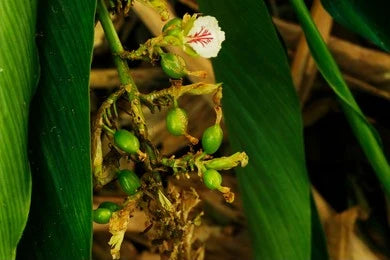Ela is a perennial herbaceous plant in the ginger family that has a strong flavor. This plant can reach heights of 2-4 meters. The 20–40 cm long, linear–lanceolate, alternating, and two-ranked leaves of this plant have sharp, pointy tips. Sword-shaped, dark green leaves. Flowers are produced in 30-60 cm long loose spikes that are either white or pale violet in color. Both male and female components can be found in flowers. Fruits are three-chambered, three-sided, yellow-green pods with many black and brown seeds within that are between one and two centimeters long. These plant's green seed pods are dried, and the seeds are used as spices in many Indian dishes.
General information
Cardamom is referred to as the "king of spices". It has a powerful, distinctive flavor, a resinous aroma, and a profoundly calming aroma. Its cooling mechanism is nearly mint-like. Since the fourth century, this herb has been utilized in cooking and healing. This plant's seeds are employed in numerous recipes. To prepare tea and reduce tension from too much work, seeds are also included. It is frequently used to freshen breath. Although the leaves of this plant don't smell like the seeds do, they are nonetheless used to wrap fish, rice, and vegetables while they are cooking. In India, this herb has been traded for 1000 years. This herb is also mentioned in Sanskrit texts dating back to the 4th century BC in Kautilya's arthashastra, where it is used in numerous rites. Mycrene, limonene, y-tirpinene, p-cymene, terpinole, geraneol, trans-nerodiol, hepatene, linalool, camphor, citral, farsneol, and sitosterol are all found in the seeds of this herb.
Habitat
Cardamom is commonly native to India. It is widely found in the Western Ghats of southern India. This area is known as the Cardamom Hills. Tropical rainforests at elevations of 2500-5000ft are best for their growth. By the 21st century, Guatemala is the largest producer of cardamom in the world. Later, it is brought to other tropical Asian regions, where it is commonly cultivated for its seeds' aromatic and therapeutic qualities. Tanzania, Guatemala, Sri Lanka, New Guinea, and other nations also have it. Additionally, it is grown in North America, Vietnam, Thailand, and Nepal.
Classification
Kingdom - Plantae
Order – Zingiberales
Family – Zingiberiaceae
Other Names
Latin name- Elettaria cardamomum
Hindi name – Chotti ellachi
English name – King of Spice, Lesser cardamom
Kannada name – Elakki
Malayalam name – Elam
Telugu name – China elakulu, Yelakkapalu
Tamil name – Yelakka
Marathi name – Velachi, Veldode
Gujarati name – Elachi, Chot elach
Arabic name – Kakul
Farsi name – Heelabak, Ilaichi khurd
Ayurvedic Properties
|
|
Hindi / Sanskrit |
English |
|
Rasa (Taste) |
Katu, Madhur |
Pungent, Sweet |
|
Guna (Physical Property) |
Laghu, Rooksha |
Light, Dry |
|
Virya (Potency) |
Sheet |
Cold |
|
Vipaka (Post-Digestive Taste) |
Katu |
Pungent |
Effects on Doshas
It pacifies kapha and pitta dosha.
|
Charak Samhita |
Sushrut Samhita |
Vagbhata |
Bhavprakash |
|
Eladi gana |
Eladi, Trijatka, Charurjatka |
Shwashara |
Practical uses
- Cardamom is used to treat indigestion, nausea, and vomiting as well as to help the body evacuate phlegm. It is highly helpful for pulmonary illnesses and lung congestion.
- Additionally, it acts as a laxative and helps to relieve griping and avoid stomach pain and flatulence.
- Seed oil benefits the digestive system greatly. It is used to soothe colic and warm the stomach, and it is fantastic for heartburn.
- Chewing on raw cardamom seeds helps the body rid itself of coffee and bad breath. Additionally, seeds are used to flavor many treatments and as a spice in cookery.
- It is used as an appetizer and is also excellent for dyspepsia.
- It is used to treat infections of the teeth and gums, as well as throat problems and inflammation of the eyelids.
- This herb is also good for people who have kidney stones.
- It is an analgesic that is best used to treat arthritis, sore muscles, and lower back discomfort.
- It has antifungal, antibacterial, and antiviral properties and is used to treat a variety of ailments.
- It is also used to relieve inflammation and is effective in cases of diarrhea.
- Tea made from boiled seeds is used to treat depression.
- Cardamom seed powder, when combined with amla juice, works as a diuretic and is particularly useful in cystitis, gonorrhea, and scanty urination.
- Cardamom seeds can help with sexual dysfunctions. This is used to treat impotence and premature ejaculation.
- Hiccups benefit greatly from seeds infused with mint leaves.
- It is utilized to balance the vata and kapha doshas.
Cautions
Pregnancy should not be the time to consume cardamom.
Patients with gallstones should avoid it.
People with sensitive skin are cautioned against using oil.
Part used
Fruit
Fruit seeds
Dosage
Seed powder - 0.5 to 1gm
Seed oil – 2-5 drops

